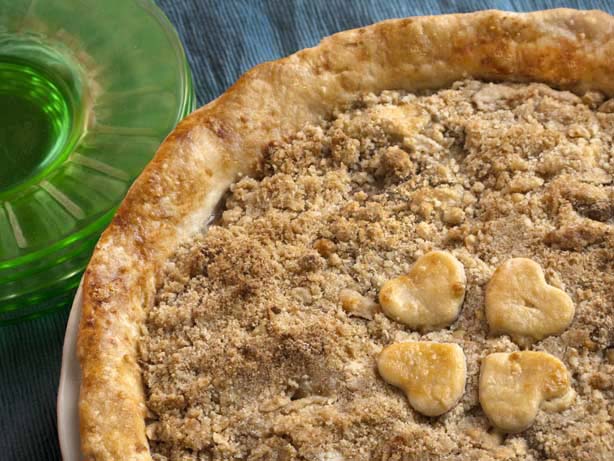 Let me begin by saying that gooseberries – would you believe – are hard to come by. In my quest to find this rare fruit, I heard tell that fresh gooseberries are actually available in season in the Bay Area at the produce market called the Berkeley Bowl, but that would mean I would have to wait until June or July, and given that I was hell-bent on continuing the Irish theme for this month’s pie by incorporating gooseberries. I had to find another source.
Let me begin by saying that gooseberries – would you believe – are hard to come by. In my quest to find this rare fruit, I heard tell that fresh gooseberries are actually available in season in the Bay Area at the produce market called the Berkeley Bowl, but that would mean I would have to wait until June or July, and given that I was hell-bent on continuing the Irish theme for this month’s pie by incorporating gooseberries. I had to find another source.
Where else to go when you’ve searched and called most of your local supermarkets (having an eerie suspicion that with some of those communiques, the supermarketeer had no idea what a gooseberry was) and coming up empty for canned berries, than Amazon, the source of everything from books to batteries to bandages. Unfortunately, you cannot order just one can of gooseberries, but being a food blogger means sometimes having to add eight cans of gooseberries to your pantry and not say you are sorry.
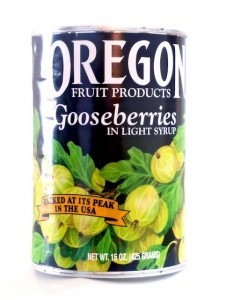 Why gooseberries? Well, I wanted to make my monthly pie say “Ireland,†and two uniquely UK fruits used prevalently are gooseberries and rhubarb. Even though we have both in cultivation in this country, you almost never see the former and rarely see the latter used. In Irish cookbooks, however, I ran across them again and again, and, as mentioned in my previous blog, ate them as the fruity components in yogurt. I wrestled with making a crumble – also a common Irish dessert – but would that really count as pie? When I finally landed on a pie recipe with the most regal title of “Heart of Ireland,†in a delightful tome called “An Irish Farmhouse Cookbook,†I was so pleased to see that the filling could include a combination of gooseberries, rhubarb and apples, so I thought I’d take a creative liberty and instead of making it with a top crust, I’d try the crumble topping recipe from “A Little Irish Cookbook.†A crumble and a pie — the best of all worlds and gooseberries to boot!
Why gooseberries? Well, I wanted to make my monthly pie say “Ireland,†and two uniquely UK fruits used prevalently are gooseberries and rhubarb. Even though we have both in cultivation in this country, you almost never see the former and rarely see the latter used. In Irish cookbooks, however, I ran across them again and again, and, as mentioned in my previous blog, ate them as the fruity components in yogurt. I wrestled with making a crumble – also a common Irish dessert – but would that really count as pie? When I finally landed on a pie recipe with the most regal title of “Heart of Ireland,†in a delightful tome called “An Irish Farmhouse Cookbook,†I was so pleased to see that the filling could include a combination of gooseberries, rhubarb and apples, so I thought I’d take a creative liberty and instead of making it with a top crust, I’d try the crumble topping recipe from “A Little Irish Cookbook.†A crumble and a pie — the best of all worlds and gooseberries to boot!
Gooseberries are a small fruit, slightly larger than a blueberry and resembling a small seedless green grape. They are very tart. They come from a bush and are a relative of the currant. Growing up, I remember our having currant bushes, their yellow blossoms emitting the spiciest aroma in early spring, then picking the nearly black berries so my mother could make jelly. Apparently, there were also gooseberry bushes on the property, but gooseberry bushes are loaded with thorns, which would explain our reticence in gathering and preparing them.
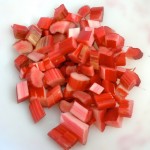 I am more familiar with rhubarb, growing up with a gardening mother who loved the stuff and cultivated several plants. Rhubarb grows in huge plants with long edible stalks ranging in color from pale green to pink to ruby red. The large, dark green frilly leaves are poisonous. As a child we ate the stringy, tangy rhubarb (tastes sort of like a sour strawberry) in various interpretations – jams, pies, cobblers, cakes. Most simply, rhubarb was stewed down with a little sugar and eaten by the bowlful (with some vanilla ice cream, perhaps). My mother said she always knew this to be called a “spring tonic.â€
I am more familiar with rhubarb, growing up with a gardening mother who loved the stuff and cultivated several plants. Rhubarb grows in huge plants with long edible stalks ranging in color from pale green to pink to ruby red. The large, dark green frilly leaves are poisonous. As a child we ate the stringy, tangy rhubarb (tastes sort of like a sour strawberry) in various interpretations – jams, pies, cobblers, cakes. Most simply, rhubarb was stewed down with a little sugar and eaten by the bowlful (with some vanilla ice cream, perhaps). My mother said she always knew this to be called a “spring tonic.â€
Just a month ago, a fellow Kansan named Jane was digging up and dividing her rhubarb (also from Kansas) and wanted to know if I would like to try to plant some. I was dubious about the possibility of it growing in my micro yard, but dug a hole in the rain, anyway. Lo and behold, within two weeks I had a baby rhubarb plant! Not enough yet to make this pie, but that day will come.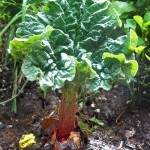
So, for my “Heart of Ireland†pie, my tangy, tarty and wide-ranging filling ingredients of gooseberries, rhubarb stalks and sliced Granny Smith apples were assembled and would be bedded down in something called a “shortcrust†pastry. I think this term might be more common in other countries (I’ve not heard it a lot here). It means, simply, a crumbly, crisp pastry dough usually made with one part fat for every two parts flour. I altered the recipe from “An Irish Farmhouse Cookbook†slightly in that I added about a teaspoon of sugar, making it a 
“sweetcrust shortcrust.†Also, the book’s recipe called for margarine as the fat. Not knowing for certain if American stick margarine and Irish margarine are akin. I instead used a mix of butter and shortening for the dough.
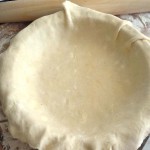 It turned out to be a very nice dough to work with (those of you reading here will know of my pie pastry anxieties.). I was able to roll it out easily to thin smooth sheet. Santa brought me a “handle-less†rolling pin, and I’m finding the hand-guided roller to be effective at urging the dough into submission. I was even able to once again roll the dough onto the pin to then unroll into the pan. Here’s a photo to prove it.
It turned out to be a very nice dough to work with (those of you reading here will know of my pie pastry anxieties.). I was able to roll it out easily to thin smooth sheet. Santa brought me a “handle-less†rolling pin, and I’m finding the hand-guided roller to be effective at urging the dough into submission. I was even able to once again roll the dough onto the pin to then unroll into the pan. Here’s a photo to prove it.
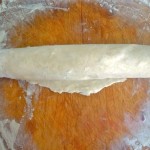 As previously mentioned. I opted for crumble topping for this pie. This topping recipe uses self-rising flour, but rather than buying any, I made my own. Here’s how: For every one cup of flour, mix in 1-1/2 teaspoon baking powder and one teaspoon salt. This recipe made more than two cups of crumble. I only used about a cup for the pie, so I threw the other half in a Ziploc bag and froze it to be used down the line.
As previously mentioned. I opted for crumble topping for this pie. This topping recipe uses self-rising flour, but rather than buying any, I made my own. Here’s how: For every one cup of flour, mix in 1-1/2 teaspoon baking powder and one teaspoon salt. This recipe made more than two cups of crumble. I only used about a cup for the pie, so I threw the other half in a Ziploc bag and froze it to be used down the line.
This turned out to be a really delicious pie, decidedly old-fashioned. Upon its first slicing, I noted the crust was crispy on the edges, but a nice contrast to the melt-in-your sweetness of the crumble topping. As for the filling, the apples gave substance, the ruby rhubarb chunks gave color and the gooseberries, while texturally nearly disintegrated and more of a mash then a berry, gave that high-pitched tartness that could be considered the Irish flute in the melody of this pie. One thing I have to mention is that, upon subsequent evenings of eating the pie, it got better. By the third night, it tasted the best of all. And then it was gone, just a memory left within a heart that grew ever fonder.
Heart of Ireland
(Adapted from “An Irish Farmhouse Cookbook†by Mary Kinsella)
1 recipe Shortcrust Pastry (see below)
1 lb. (4 cups) fruit (gooseberries, rhubarb, apples
½ cup sugar
A little beaten egg or milk
Make pastry and leave covered in the refrigerator. Meantime prepare the fruit by mixing it together with the sugar (blogger’s note: I also squeezed about a tablespoon of fresh lemon juice over the apple to keep it from browning). Roll out pastry to cover a 9-inch pie pan. Trim the edges of pastry and flute as desired. Fill pastry shell with fruit. Top fruit with Crumble Topping (see below) and press lightly. With excess pastry, you may cut shapes to decorate top of pie. Brush pastry edges and décor with beaten egg. This recipe suggests baking the pie at 400 degrees – I baked it at 375 for about 45 minutes, covering the top loosely with foil the last 15 to 20 minutes to prevent overbrowning.
Shortcrust Pastry
(Adapted from “An Irish Farmhouse Cookbook†by Mary Kinsella)
1 ½ cups plain flour
Pinch of salt
1 teaspoon of sugar
1/3 cup margarine (or a combination of butter and shortening
Cold water
Sieve flour and salt into a bowl. Cut up margarine and rub into the flour with tips of fingers until the mixture resembles fine breadcrumbs. Add enough cold water to make a firm dough, mixing with a knife. Turn out onto a lightly floured bowl and knead lightly with tips of fingers. Form into a bowl and chill until ready to use (at least ½ hour).
Crumble Topping
(From “A Little Irish Cookbook†by John Murphy)
2 cups self-rising flour
½ cup soft brown sugar
½ cup butter
Using your fingertips, rub in the butter lightly into the flour in a large bowl. When it is like fine breadcrumbs mix in the brown sugar.